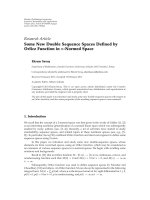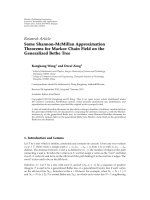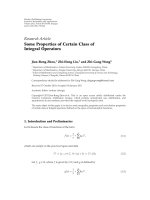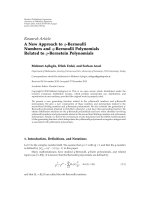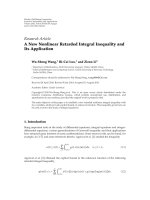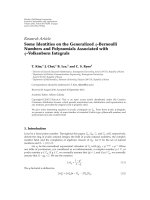Báo cáo hóa học: " Research Article Some New Results Related to Favard’s Inequality" pot
Bạn đang xem bản rút gọn của tài liệu. Xem và tải ngay bản đầy đủ của tài liệu tại đây (510.97 KB, 14 trang )
Hindawi Publishing Corporation
Journal of Inequalities and Applications
Volume 2009, Article ID 128486, 14 pages
doi:10.1155/2009/128486
Research Article
Some New Results Related to Favard’s Inequality
Naveed Latif,
1
J. P e
ˇ
cari
´
c,
1, 2
and I. Peri
´
c
3
1
Abdus Salam School of Mathematical Sciences, GC University, Lahore 54000, Pakistan
2
Faculty of Textile Technology, University of Zagreb, 10000 Zagreb, Croatia
3
Faculty of Food Technology and Biotechnology, University of Zagreb, 10000 Zagreb, Croatia
Correspondence should be addressed to Naveed Latif,
Received 31 July 2008; Revised 17 January 2009; Accepted 5 February 2009
Recommended by A. Laforgia
Log-convexity of Favard’s difference is proved, and Drescher’s and Lyapunov’s type inequalities
for this difference are deduced. The weighted case is also considered. Related Cauchy type means
are defined, and some basic properties are given.
Copyright q 2009 Naveed Latif et al. This is an open access article distributed under the Creative
Commons Attribution License, which permits unrestricted use, distribution, and reproduction in
any medium, provided the original work is properly cited.
1. Introduction and Preliminaries
Let f and p be two positive measurable real valued functions defined on a, b ⊆ R with
b
a
pxdx 1. From theory of convex means cf. 1, 2, the well-known Jensen’s inequality
gives that for t<0ort>1,
b
a
pxf
t
xdx ≥
b
a
pxfxdx
t
, 1.1
and reverse inequality holds for 0 <t<1. In 3, Simic considered the difference
D
s
D
s
a, b, f, p
b
a
pxf
s
xdx −
b
a
pxfxdx
s
. 1.2
He has given the following.
2 Journal of Inequalities and Applications
Theorem 1.1. Let f and p be nonnegative and integrable functions on a, b,with
b
a
pxdx 1,
then for 0 <r<s<t,r,s,t
/
1, one has
D
s
ss − 1
t−r
≤
D
r
rr − 1
t−s
D
t
tt − 1
s−r
. 1.3
Remark 1.2. For an extension of Theorem 1.1 see 3.
Let us write the well-known Favard’s inequality.
Theorem 1.3. Let f be a concave nonnegative function on a, b ⊂ R.Ifq>1,then
2
q
q 1
1
b − a
b
a
fxdx
q
≥
1
b − a
b
a
f
q
xdx. 1.4
If 0 <q<1, the reverse inequality holds in 1.4.
Note that 1.4 is a reversion of 1.1 in the case when px1/b − a.
Let us note that Theorem 1.3 can be obtained from the following result and also
obtained by Favard cf. 4, page 212.
Theorem 1.4. Let f be a nonnegative continuous concave function on a, b, not identically zero, and
let φ be a convex function on 0, 2
f,where
f
1
b − a
b
a
fxdx. 1.5
Then
1
2
f
2
f
0
φydy ≥
1
b − a
b
a
φ
fx
dx. 1.6
Karlin and Studden cf. 5, page 412 gave a more general inequality as follows.
Theorem 1.5. Let f be a nonnegative continuous concave function on a, b, not identically zero;
f
is defined in 1.5, and let φ be a convex function on c, 2
f − c, where c satisfies 0 <c≤ f
min
(where
f
min
is the minimum of f). Then
1
2
f − 2c
2
f−c
c
φydy ≥
1
b − a
b
a
φ
fx
dx. 1.7
For φyy
p
, p>1, we can get the following from Theorem 1.5.
Journal of Inequalities and Applications 3
Theorem 1.6. Let f be continuous concave function such that 0 <c≤ f
min
;
f is defined in 1.5.If
p>1,then
1
2
f − 2c
p 1
2
f − c
p1
− c
p1
≥
1
b − a
b
a
f
p
xdx. 1.8
If 0 <p<1, the reverse inequality holds in 1.8.
In this paper, we give a related results to 1.3 for Favard’s inequality 1.4 and 1.8.
We need the following definitions and lemmas.
Definition 1.7. It is said that a positive function f is log-convex in the Jensen sense on some
interval I ⊆ R if
fsft ≥ f
2
s t
2
1.9
holds for every s, t ∈ I.
We quote here another useful lemma from log-convexity theory cf. 3.
Lemma 1.8. A positive function f is log-convex in the Jensen sense on an interval I ⊆ R if and only
if the relation
u
2
fs2uwf
s t
2
w
2
ft ≥ 0 1.10
holds for each real u, w and s, t ∈ I.
Throughout the paper, we will frequently use the following family of convex functions
on 0, ∞:
ϕ
s
x
⎧
⎪
⎪
⎪
⎪
⎨
⎪
⎪
⎪
⎪
⎩
x
s
ss − 1
,s
/
0, 1;
− log x, s 0;
x log x, s 1.
1.11
The following lemma is equivalent to the definition of convex function see 4, page
2.
Lemma 1.9. If φ is convex on an interval I ⊆ R,then
φ
s
1
s
3
− s
2
φ
s
2
s
1
− s
3
φ
s
3
s
2
− s
1
≥ 0 1.12
holds for every s
1
<s
2
<s
3
,s
1
,s
2
,s
3
∈ I.
Now, we will give our main results.
4 Journal of Inequalities and Applications
2. Favard’s Inequality
In the following theorem, we construct another interesting family of functions satisfying the
Lyapunov inequality. The proof is motivated by 3.
Theorem 2.1. Let f be a positive continuous concave function on a, b;
f is defined in 1.5, and
Δ
s
f :
⎧
⎪
⎪
⎪
⎪
⎪
⎪
⎪
⎪
⎪
⎪
⎨
⎪
⎪
⎪
⎪
⎪
⎪
⎪
⎪
⎪
⎪
⎩
1
ss − 1
2
s
s 1
1
b − a
b
a
fxdx
s
−
1
b − a
b
a
f
s
xdx
,s
/
0, 1;
1 − log 2 − log
f
1
b − a
b
a
log fxdx, s 0;
log 2
f
f log
f −
1
2
f −
1
b − a
b
a
fx log fxdx, s 1.
2.1
Then Δ
s
f is log-convex for s ≥ 0, and the following inequality holds for 0 ≤ r<s<t<∞:
Δ
t−r
s
f ≤ Δ
t−s
r
fΔ
s−r
t
f. 2.2
Proof. Let us consider the function defined by
φxu
2
ϕ
s
x2uwϕ
r
xw
2
ϕ
t
x, 2.3
where r s t/2, ϕ
s
is defined by 1.11,andu, w ∈ R. We have
φ
xu
2
x
s−2
2uwx
r−2
w
2
x
t−2
ux
s/2−1
wx
t/2−1
2
≥ 0,x>0.
2.4
Therefore, φx is convex for x>0. Using Theorem 1.4,
1
2
f
2
f
0
u
2
ϕ
s
y2uwϕ
r
yw
2
ϕ
t
y
dy
≥
1
b − a
b
a
u
2
ϕ
s
fx
2uwϕ
r
fx
w
2
ϕ
t
fx
dx,
2.5
Journal of Inequalities and Applications 5
or equivalently
u
2
1
2
f
2
f
0
ϕ
s
ydy −
1
b − a
b
a
ϕ
s
fxdx
2uw
1
2
f
2
f
0
ϕ
r
ydy −
1
b − a
b
a
ϕ
r
fx
dx
w
2
1
2
f
2
f
0
ϕ
t
ydy −
1
b − a
b
a
ϕ
t
fx
dx
≥ 0.
2.6
Since
Δ
s
f
1
2
f
2
f
0
ϕ
s
ydy −
1
b − a
b
a
ϕ
s
fx
dx, 2.7
we have
u
2
Δ
s
f2uwΔ
r
fw
2
Δ
t
f ≥ 0. 2.8
By Lemma 1.8, we have
Δ
s
fΔ
t
f ≥ Δ
2
r
fΔ
2
st/2
f, 2.9
that is, Δ
s
f is log-convex in the Jensen sense for s ≥ 0.
Note that Δ
s
f is continuous for s ≥ 0since
lim
s → 0
Δ
s
fΔ
0
f and lim
s → 1
Δ
s
fΔ
1
f. 2.10
This implies Δ
s
f is continuous; therefore, it is log-convex.
Since Δ
s
f is log-convex, that is, s → log Δ
s
f is convex, by Lemma 1.9 for 0 ≤ r<
s<t<∞ and taking φslog Δ
s
f,weget
log Δ
t−r
s
f ≤ logΔ
t−s
r
flog Δ
s−r
t
f, 2.11
which is equivalent to 2.2.
Theorem 2.2. Let f, Δ
s
f be defined as in Theorem 2.1, and let t, s, u, v be nonnegative real numbers
such that s ≤ u, t ≤ v, s
/
t, and u
/
v.Then
Δ
t
f
Δ
s
f
1/t−s
≤
Δ
v
f
Δ
u
f
1/v−u
. 2.12
6 Journal of Inequalities and Applications
Proof. An equivalent form of 1.12 is
ϕ
x
2
− ϕx
1
x
2
− x
1
≤
ϕ
y
2
− ϕ
y
1
y
2
− y
1
, 2.13
where x
1
≤ y
1
, x
2
≤ y
2
, x
1
/
x
2
,andy
1
/
y
2
. Since by Theorem 2.1, Δ
s
f is log-convex, we can
set in 2.13: ϕxlog Δ
x
f, x
1
s, x
2
t, y
1
u,andy
2
v.Weget
log Δ
t
f − log Δ
s
f
t − s
≤
log Δ
v
f − log Δ
u
f
v − u
, 2.14
from which 2.12 trivially follows.
The following extensions of Theorems 2.1 and 2.2 can be deduced in the same way
from Theorem 1.5.
Theorem 2.3. Let f be a continuous concave function on a, b such that 0 <c≤ f
min
;
f is defined
in 1.5, and
Δ
s
f :
⎧
⎪
⎪
⎪
⎪
⎪
⎪
⎪
⎪
⎪
⎪
⎪
⎪
⎪
⎪
⎪
⎪
⎪
⎨
⎪
⎪
⎪
⎪
⎪
⎪
⎪
⎪
⎪
⎪
⎪
⎪
⎪
⎪
⎪
⎪
⎪
⎩
1
ss − 1
2
f − c
s1
2
f − 2c
s 1
−
c
s1
2
f − 2c
s 1
−
1
b − a
b
a
f
s
xdx
,s
/
0, 1;
1
2
f − 2c
2
f c log c − 2c −
2
f − c
log
2
f − c
1
b − a
b
a
log fxdx, s 0;
1
22
f − 2c
2
f − c
2
log
2
f − c
− 2
f
2
2c
f − c
2
log c 2c
−
1
b − a
b
a
fx log fxdx, s 1.
2.15
Then
Δ
s
f is log-convex for s ≥ 0, and the following inequality holds for 0 ≤ r<s<t<∞:
Δ
t−r
s
f ≤
Δ
t−s
r
f
Δ
s−r
t
f. 2.16
Theorem 2.4. Let f,
Δ
s
f be defined as in Theorem 2.3, and let t, s, u, v be nonnegative real numbers
such that s ≤ u, t ≤ v, s
/
t, and u
/
v, one has
Δ
t
f
Δ
s
f
1/t−s
≤
Δ
v
f
Δ
u
f
1/v−u
. 2.17
3. Weighted Favard’s Inequality
The weighted version of Favard’s inequality was obtained by Maligranda et al. in 6.
Journal of Inequalities and Applications 7
Theorem 3.1. 1 Let f be a positive increasing concave function on a, b. Assume that φ is a convex
function on 0, ∞,where
f
i
b − a
b
a
ftwtdt
2
b
a
t − awtdt
. 3.1
Then
1
b − a
b
a
φ
ft
wtdt ≤
1
0
φ
2r
f
i
w
a1 − rbr
dr. 3.2
If f is an increasing convex function on a, b and fa0, then the reverse inequality in 3.2 holds.
2 Let f be a positive decreasing concave function on a, b. Assume that φ is a convex
function on 0, ∞,where
f
d
b − a
b
a
ftwtdt
2
b
a
b − twtdt
. 3.3
Then
1
b − a
b
a
φ
ft
wtdt ≤
1
0
φ
2r
f
d
w
ar b1 − r
dr. 3.4
If f is a decreasing convex function on a, b and fb0, then the reverse inequality in 3.4 holds.
Theorem 3.2. 1 Let f be a positive increasing concave function on a, b;
f
i
is defined in 3.1, and
Π
s
f :
1
0
ϕ
s
2r
f
i
w
a1 − rbr
dr −
1
b − a
b
a
ϕ
s
ft
wtdt. 3.5
Then Π
s
f is log-convex on 0, ∞, and the following inequality holds for 0 ≤ r<s<t<∞:
Π
t−r
s
f ≤ Π
t−s
r
fΠ
s−r
t
f. 3.6
2 Let f be an increasing convex function on a, b, fa0,
Π
s
f : −Π
s
f.Then
Π
s
f
is log-convex on 0, ∞, and the following inequality holds for 0 ≤ r<s<t<∞:
Π
t−r
s
f ≤
Π
t−s
r
f
Π
s−r
t
f. 3.7
Proof. As in the proof of Theorem 2.1,weuseTheorem 3.11 instead of Theorem 1.4.
8 Journal of Inequalities and Applications
Theorem 3.3. 1 Let f and Π
s
f be defined as in Theorem 3.2(1), and let t, s, u, v ≥ 0 be such that
s ≤ u, t ≤ v, s
/
t, and u
/
v.Then
Π
t
f
Π
s
f
1/t−s
≤
Π
v
f
Π
u
f
1/v−u
. 3.8
2 Let f and
Π
s
f be defined as in Theorem 3.2(2), and let t, s, u, v ≥ 0 be such that s ≤ u,
t ≤ v, s
/
t, and u
/
v. Then,
Π
t
f
Π
s
f
1/t−s
≤
Π
v
f
Π
u
f
1/v−u
. 3.9
Proof. Similar to the proof of Theorem 2.2.
Theorem 3.4. 1 Let f be a positive decreasing concave function on a, b;
f
d
is defined as in 3.3,
and
Γ
s
f :
1
0
ϕ
s
2r
f
d
w
ar b1 − r
dr −
1
b − a
b
a
ϕ
s
ft
wtdt. 3.10
Then Γ
s
f is log-convex on 0, ∞, and the following inequality holds for 0 ≤ r<s<t<∞:
Γ
t−r
s
f ≤ Γ
t−s
r
fΓ
s−r
t
f. 3.11
2 Let f be a decreasing convex function on a, b, fb0,
Γ
s
f : −Γ
s
f.Then
Γ
s
is
log-convex on 0, ∞, and the following inequality holds for 0 ≤ r<s<t<∞:
Γ
t−r
s
f ≤
Γ
t−s
r
f
Γ
s−r
t
f. 3.12
Proof. As in the proof of Theorem 2.1,weuseTheorem 3.12 instead of Theorem 1.4.
Theorem 3.5. 1 Let f and Γ
s
f be defined as in Theorem 3.4(1), and let t, s, u, v ≥ 0 be such that
s ≤ u, t ≤ v, s
/
t, and u
/
v.Then
Γ
t
f
Γ
s
f
1/t−s
≤
Γ
v
f
Γ
u
f
1/v−u
. 3.13
2 Let f and
Γ
s
f be defined as in Theorem 3.4(2), and let t,s, u, v ≥ 0 be such that s ≤ u,
t ≤ v, s
/
t, and u
/
v.Then
Γ
t
f
Γ
s
f
1/t−s
≤
Γ
v
f
Γ
u
f
1/v−u
. 3.14
Journal of Inequalities and Applications 9
Proof. Similar to the proof of Theorem 2.2.
Remark 3.6. Let w ≡ 1. If f is a positive concave function on a, b, then the decreasing
rearrangement f
∗
is concave on a, b. By applying Theorem 3.4 to f
∗
,weobtainthatΓ
s
f
∗
is
log-convex. Equimeasurability of f with f
∗
gives Γ
s
fΓ
s
f
∗
and we see that Theorem 3.4
is equivalent to Theorem 2.1.
Remark 3.7. Let wtt
α
with α>−1. Then Theorem 3.2 gives that if f is a positive increasing
concave function on 0, 1, then Π
α
s
is log-convex, and
Π
α
s
1
ss − 1
α 2
s
α s 1
1
0
ftt
α
dt
s
−
1
0
f
s
tt
α
dt
,s
/
0, 1,
Π
α
0
1
0
log ftt
α
dt −
log
α 2
1
0
ftt
α
dt
α 1
1
α 1
2
,
Π
α
1
log
α 2
1
0
ftt
α
dt
1
0
ftt
α
dt −
1
0
ftt
α
dt
α 2
−
1
0
ft log ftt
α
dt,
3.15
with zero for the function ftt.
If f is a positive decreasing concave function on 0, 1, then Theorem 3.4 gives that Γ
α
s
is log-convex, and
Γ
α
s
1
ss − 1
α 1
s
α 2
s
Bs 1,α 1
1
0
ftt
α
dt
s
−
1
0
f
s
tt
α
dt
,s
/
0, 1,
Γ
α
0
1
0
log ftt
α
dt
1
α 1
Hα 1 −
1
α 1
log
α 1α 2
1
0
ftt
α
dt
,
Γ
α
1
1 − Hα 2log
α 1α 2
1
0
ftt
α
dt
1
0
ftt
α
dt log
1
0
ftt
α
dt −
1
0
ft log ftt
α
dt,
3.16
with zero for the function ft1 − t, where B·, · is the beta function, and Hα is the
harmonic number defined for α>−1withHαψα 1γ, where ψ is the digamma
function and γ 0.577215 the Euler constant.
4. Cauchy Means
Let us note that 2.12, 2.17, 3.8, 3.9, 3.13,and3.14 have the form of some known
inequalities between means e.g., Stolarsky means, Gini means, etc..Herewewillprove
that expressions on both sides of 3.8 are also means. The proofs in the remaining cases are
analogous.
10 Journal of Inequalities and Applications
Lemma 4.1. Let h ∈ C
2
I, I interval in R, be such that h
is bounded, that is, m ≤ h
≤ M. Then
the functions φ
1
,φ
2
defined by
φ
1
t
M
2
t
2
− ht,φ
2
tht −
m
2
t
2
, 4.1
are convex functions.
Theorem 4.2. Let w be a nonnegative integrable function on a, b with
b
a
wxdx 1.Letf be a
positive increasing concave function on a, b, h ∈ C
2
0, 2
f
i
. Then there exists ξ ∈ 0, 2
f
i
,such
that
1
0
h
2r
f
i
w
a1 − rbr
dr −
1
b − a
b
a
h
ft
wtdt
h
ξ
2
1
0
2r
f
i
2
w
a1 − rbr
dr −
1
b − a
b
a
f
2
twtdt
.
4.2
Proof. Set m min
x∈0,2
f
i
h
x, M max
x∈0,2
f
i
h
x. Applying 3.2 for φ
1
and φ
2
defined
in Lemma 4.1, we have
1
0
φ
1
2r
f
i
w
a1 − rbr
dr ≥
1
b − a
b
a
φ
1
ft
wtdt,
1
0
φ
2
2r
f
i
w
a1 − rbr
dr ≥
1
b − a
b
a
φ
2
ft
wtdt,
4.3
that is,
M
2
1
0
2r
f
i
2
w
a1 − rbr
dr −
1
b − a
b
a
f
2
twtdt
≥
1
0
h2r
f
i
w
a1 − rbr
dr −
1
b − a
b
a
h
ft
wtdt,
4.4
1
0
h
2r
f
i
w
a1 − rbr
dr −
1
b − a
b
a
h
ft
wtdt
≥
m
2
1
0
2r
f
i
2
w
a1 − rbr
dr −
1
b − a
b
a
f
2
twtdt
.
4.5
By combining 4.4 and 4.5, 4.2 follows from continuity of h
.
Journal of Inequalities and Applications 11
Theorem 4.3. Let f be a positive increasing concave nonlinear function on a, b, and let w be a
nonnegative integrable function on a, b with
b
a
wxdx 1.Ifh
1
,h
2
∈ C
2
0, 2
f
i
, then there
exists ξ ∈ 0, 2
f
i
such that
h
1
ξ
h
2
ξ
1
0
h
1
2r
f
i
w
a1 − rbr
dr − 1/b − a
b
a
h
1
ft
wtdt
1
0
h
2
2r
f
i
w
a1 − rbr
dr − 1/b − a
b
a
h
2
ft
wtdt
, 4.6
provided that h
2
x
/
0 for every x ∈ 0, 2
f
i
.
Proof. Define the functional Φ : C
2
0, 2
f
i
→ R with
Φh
1
0
h
2r
f
i
w
a1 − rbr
dr −
1
b − a
b
a
h
ft
wtdt, 4.7
and set h
0
Φh
2
h
1
− Φh
1
h
2
. Obviously, Φh
0
0. Using Theorem 4.2 , there exists ξ ∈
0, 2
f
i
such that
Φh
0
h
0
ξ
2
1
0
2r
f
i
2
w
a1 − rbr
dr −
1
b − a
b
a
f
2
twtdt
. 4.8
We give a proof that the expression in square brackets in 4.8 is nonzero actually strictly
positive by inequality 3.2 for nonlinear function f. Suppose that the expression in square
brackets in 4.8 is equal to zero, which is by simple rearrangements equivalent to equality
b
a
t − a
2
wtdt
b
a
g
2
twtdt, where gt
b
a
t − awtdt
b
a
ftwtdt
ft. 4.9
Since g is positive concave function, it is easy to see that gt/t − a is decreasing function
on a, bsee 6,thus
1
1
b
a
t − awtdt
b
a
gtwtdt ≤
1
x
a
t − awtdt
x
a
gtwtdt, x ∈ a, b, 4.10
so
x
a
t − awtdt ≤
x
a
gtwtdt for every x ∈ a, b.Set
Fx
x
a
t − a − gt
wtdt. 4.11
12 Journal of Inequalities and Applications
Obviously, Fx ≤ 0, FaFb0. By 4.9, obvious estimations and integration by parts,
we have
0
b
a
t − a
2
− g
2
t
wtdt ≥
b
a
2gt
t − a − gt
wtdt
b
a
2gtdFt−
b
a
Ftd
2gt
≥ 0.
4.12
This implies
b
a
t − a
2
− g
2
twtdt
b
a
2gtt − a − gtwtdt, which is equivalent to
b
a
t − a − gt
2
wtdt 0. This gives that g is a linear function, which obviously implies
that f is a linear function.
Since the function f is nonlinear, the expression in square brackets in 4.8 is strictly
positive which implies that h
0
ξ0, and this gives 4.6.NoticethatTheorem 4.2 for h h
2
implies that the denominator of the right-hand side of 4.6 is nonzero.
Corollary 4.4. Let w be a nonnegative integrable function with
b
a
wxdx 1.Iff is a positive
increasing concave nonlinear function on a, b, then for 0 <s
/
t
/
1
/
s there exists ξ ∈ 0, 2
f
i
such
that
ξ
t−s
ss − 1
tt − 1
1
0
2r
f
i
t
w
a1 − rbr
dr − 1/b − a
b
a
f
t
rwrdr
1
0
2r
f
i
s
w
a1 − rbr
dr − 1/b − a
b
a
f
s
rwrdr
. 4.13
Proof. Set h
1
xx
t
and h
2
xx
s
,t
/
s
/
0, 1in4.6, then we get 4.13.
Remark 4.5. Since the function ξ → ξ
t−s
is invertible, then from 4.13 we have
0
<
⎛
⎝
ss − 1
tt − 1
1
0
2r
f
i
t
w
a1 − rbr
dr− 1/b − a
b
a
f
t
rwrdr
1
0
2r
f
i
s
w
a1 − rbr
dr− 1/b − a
b
a
f
s
rwrdr
⎞
⎠
1/t−s
≤
2
f
i
.
4.14
In fact, similar result can also be given for 4.6. Namely, suppose that h
1
/h
2
has
inverse function. Then from 4.6, we have
ξ
h
1
h
2
−1
⎛
⎝
1
0
h
1
2r
f
i
w
a1 − rbr
dr − 1/b − a
b
a
h
1
ft
wtdt
1
0
h
2
2r
f
i
w
a1 − rbr
dr − 1/b − a
b
a
h
2
ft
wtdt
⎞
⎠
. 4.15
So, we have that the expression on the right-hand side of 4.15 is also a mean.
By the inequality 4.14, we can consider
M
t,s
f; w
⎛
⎝
ss − 1
tt − 1
1
0
2r
f
i
t
w
a1 − rbr
dr − 1/b − a
b
a
f
t
rwrdr
1
0
2r
f
i
s
w
a1 − rbr
dr − 1/b − a
b
a
f
s
rwrdr
⎞
⎠
1/t−s
4.16
Journal of Inequalities and Applications 13
for 0 <t
/
s
/
1
/
t as means in broader sense. Moreover, we can extend these means in other
cases.
Denote, μrwa1 − rbr and νrwr. So by limit, we have
log M
t,t
f; w
1
0
2r
f
i
t
log
2r
f
i
μr dr − 1/b − a
b
a
f
t
r log frν rdr
1
0
2r
f
i
t
μr dr − 1/b − a
b
a
f
t
rνr dr
−
2t − 1
tt − 1
,t
/
0, 1,
log M
0,0
f; w
1/b − a
b
a
log
2
frνr dr −
1
0
log
2
2r
f
i
μr dr
2/b − a
b
a
log frνr dr − 2
1
0
log
2r
f
i
μr dr
−
2
1
0
log2r
f
i
μ rdr − 2/b − a
b
a
log frνr dr
2/b − a
b
a
log frνr dr − 2
1
0
log
2r
f
i
μr dr
,
log M
1,1
f; w
2
f
i
1
0
r log
2r
f
i
log
2r
f
i
− 2
μr dr − 1/b − a
b
a
fr log fr
log fr − 2
νr dr
2
1
0
2r
f
i
log
2r
f
i
μr dr − 2/b − a
b
a
fr log frνr dr
.
4.17
In our next result, we prove that this new mean is monotonic.
Theorem 4.6. Let t ≤ u, r ≤ s, then the following inequality is valid:
M
t,r
f; w ≤ M
u,s
f; w. 4.18
Proof. Since Π
s
is log-convex, therefore by 3.8 we get 4.18.
Remark 4.7. If w ≡ 1, then the above means become
M
t,s
f;1
⎛
⎝
1/2
f
2
f
0
ϕ
t
ydy − 1/b − a
b
a
ϕ
t
fx
dx
1/2
f
2
f
0
ϕ
s
ydy − 1/b − a
b
a
ϕ
s
fx
dx
⎞
⎠
1/t−s
, 0 <t
/
s,
log M
t,t
f;1
2
t
/t 1
f
t
log
f
f
t
2
t
log 2/t 1
−
f
t
2
t
/t 1
2
− 1/b − a
b
a
f
t
x log fxdx
tt − 1Δ
t
f
−
2t − 1
tt − 1
,t
/
0, 1,
14 Journal of Inequalities and Applications
log M
0,0
f;1
1/b − a
b
a
log
2
fxdx 2/b − a
b
a
log fxdx − log
2
f − 2log2log
f − log
2
2
2 2/b − a
b
a
log fxdx − 2log
2
f
,
log M
1,1
f;1
f log
f log4
f/e
3
f
log
2
2 − log 8 3/2
− 1/b − a
b
a
fx log fx
log fx − 2
dx
2
f log
2
f
−
f − 2/b − a
b
a
fx log fxdx
.
4.19
In this way 4.18 for w ≡ 1 gives an extension of 2.12see Remark 3.6.
Acknowledgments
This research work is funded by Higher Education Commission Pakistan. The researches
of the second author and third author are supported by the Croatian Ministry of Science,
Education and Sports under the Research Grants 117-1170889-0888 and 058-1170889-1050,
respectively.
References
1 G. H. Hardy, J. E. Littlewood, and G. P
´
olya, Inequalities, Cambridge University Press, Cambridge, UK,
1978.
2 D. S. Mitrinovi
´
c, Analytic Inequalities, vol. 165 of Die Grundlehren der mathematischen Wissenschaften,
Springer, Berlin, Germany, 1970.
3 S. Simic, “On logarithmic convexity for differences of power means,” Journal of Inequalities and
Applications, vol. 2007, Article ID 37359, 8 pages, 2007.
4 J. E. Pe
ˇ
cari
´
c, F. Proschan, and Y. L. Tong, Convex Functions, Partial Orderings, and Statistical Applications,
vol. 187 of Mathematics in Science and Engineering, Academic Press, Boston, Mass, USA, 1992.
5 S. Karlin and W. J. Studden, Tchebyc heff Systems: With Applications in Analysis and Statistics, vol. 15 of
Pure and Applied Mathematics, Interscience, New York, NY, USA, 1966.
6 L. Maligranda, J. E. Pe
ˇ
cari
´
c, and L. E. Persson, “Weighted Favard and Berwald inequalities,” Journal of
Mathematical Analysis and Applications, vol. 190, no. 1, pp. 248–262, 1995.
